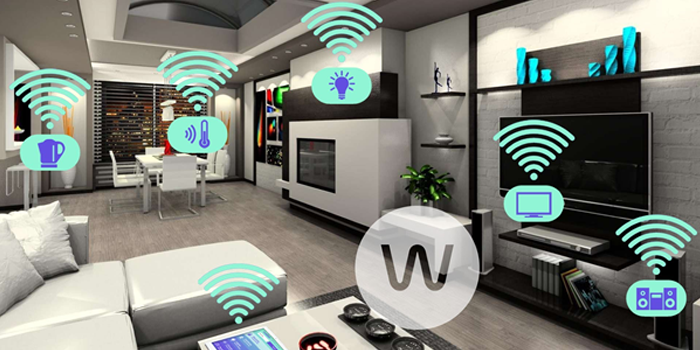Create a Smart Home with Connected Devices and Automation
Selecting a smart home with connected devices ecosystem is crucial, as it will influence the compatibility of your devices

In today's fast-paced world, home with connected devices continues to evolve, making our lives more convenient and efficient. One of the most prominent advancements in recent years has been the concept of a "smart home."
A smart home is equipped with connected devices and automation systems that enable homeowners to control and monitor various aspects of their living space remotely.
In this blog post, we'll explore how to create a smart home with connected devices and automation to enhance your lifestyle, improve energy efficiency, and bolster home security.
Understanding the Home with Connected Devices Basics
What is a Smart Home?
A smart home is a residence that utilizes technology to automate and enhance daily tasks and routines. It incorporates connected devices, sensors, and automation systems that can be controlled remotely through smartphones, tablets, or voice commands. The primary goal of a smart home is to make life more convenient, energy-efficient, and secure.
Key Components of a Smart Home
- Connected Devices: These are the building blocks of a smart home. Connected devices include smart thermostats, lights, locks, cameras, speakers, and more. These devices can communicate with each other and with a central hub or controller.
- Automation Hub/Controller: This central brain of your smart home connects and manages all the devices. Popular options include Amazon Alexa, Google Home, and Apple HomeKit.
- Sensors: Sensors like motion detectors, door/window sensors, and environmental sensors provide data to the automation system, enabling it to make informed decisions.
- Voice Assistants: Voice-activated devices like Amazon Echo and Google Home allow you to control your smart home using voice commands.
- Smartphone App: Most smart home systems have a dedicated app that enables you to monitor and control your devices remotely.
Now that we have a basic understanding of what constitutes a smart home, let's delve into the steps to create one.
Building Your Smart Home
Step 1: Define Your Goals and Budget
Start by determining your objectives for creating a smart home. What do you want to achieve? Whether it's energy savings, convenience, security, or all of the above, setting clear goals will help you plan your smart home effectively. Additionally, establish a budget to ensure that your project remains financially manageable.
Step 2: Choose Your Ecosystem
Selecting a smart home with connected devices ecosystem is crucial, as it will influence the compatibility of your devices. Common ecosystems include:
- Amazon Alexa: Compatible with a wide range of devices and known for its voice control capabilities.
- Google Assistant: Works seamlessly with Google devices and has robust voice recognition.
- Apple HomeKit: Designed for iOS users, it provides strong security and privacy features.
- Samsung SmartThings: Offers excellent compatibility with a variety of brands and devices.
Consider your existing devices and preferences when choosing an ecosystem, as it will dictate which products you can integrate into your smart home.
Step 3: Start with the Essentials
Begin your journey into the world of smart homes by installing essential devices:
a. Smart Lighting
Replace traditional bulbs with smart bulbs or switches. These can be scheduled, dimmed, and controlled remotely. Examples include Philips Hue and LIFX.
b. Smart Thermostat
Install a smart thermostat like the Nest Learning Thermostat or ecobee. They learn your preferences and optimize your heating and cooling for energy efficiency.
c. Smart Security
Enhance home security with smart cameras, doorbell cameras, and door/window sensors. Brands like Ring, Arlo, and Nest offer excellent options.
Step 4: Expand Gradually
Once you've integrated the basics, expand your smart home ecosystem with additional devices:
a. Voice Assistants
Set up voice assistants like Amazon Echo or Google Home for hands-free control of your smart devices.
b. Smart Locks
Upgrade your door locks with smart locks that offer keyless entry and remote access. Brands like August and Schlage provide reliable options.
c. Smart Speakers
Add smart speakers for a more immersive experience, enabling you to control your music, lights, and more with voice commands.
d. Environmental Sensors
Monitor indoor air quality, humidity, and temperature with environmental sensors to ensure a healthy living environment.
Step 5: Automation and Integration
The true power of a smart home lies in automation and integration. Use your ecosystem's app to create custom routines and automation rules. For example:
- Morning Routine: Have your lights gradually brighten, your thermostat adjust to your preferred temperature, and your coffee maker start brewing as you wake up.
- Away Mode: When you leave home, set your security system to arm, lights to turn off, and thermostat to an energy-saving mode.
- Movie Night: Dim the lights, close the curtains, and turn on your home theater system with a single voice command.
Step 6: Data Security and Privacy
Protect your smart home from potential cybersecurity threats by following these best practices:
- Regularly update your devices' firmware and software.
- Create strong, unique passwords for each device and change them periodically.
- Enable two-factor authentication where available.
- Review and adjust privacy settings on your devices and apps to limit data sharing.
Future-Proofing Your Smart Home Devices
As technology continues to advance, it's essential to future-proof your smart home:
Stay Informed
Keep up with the latest developments in smart home technology to know when it's time to upgrade or expand your system.
Compatibility
When adding new devices, ensure they are compatible with your existing ecosystem or hub.
Energy Efficiency
Consider energy-efficient devices to reduce your carbon footprint and energy bills.
Sustainability
Dispose of old devices responsibly and recycle electronic waste to reduce environmental impact.
Creating a smart home with connected devices and automation can significantly improve your quality of life. From convenience and energy savings to enhanced security, a smart home offers a plethora of benefits.
By following the steps outlined in this guide, you can embark on your smart home journey with confidence. Remember to set clear goals, choose the right ecosystem, and gradually expand and customize your smart home to suit your unique needs. Embrace the future of living and enjoy the endless possibilities of a smart home!
What's Your Reaction?
















